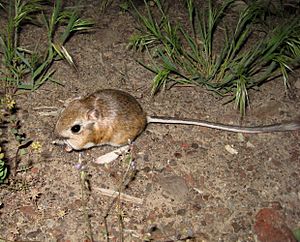Pale kangaroo mouse facts for kids
Quick facts for kids Pale kangaroo mouse |
|
|---|---|
 |
|
| A Pale Kangaroo Mouse in Nevada | |
| Conservation status | |
| Scientific classification | |
| Genus: |
Microdipodops
|
| Species: |
pallidus
|
The pale kangaroo mouse (Microdipodops pallidus) is a small rodent that lives in the deserts of California and Nevada in the United States. It's also sometimes called the Soda Spring Valley kangaroo mouse. This unique mouse is found only in these areas, meaning it is endemic to them.
Contents
Meet the Pale Kangaroo Mouse
This mouse gets its name from its pale fur and its long back legs, which it uses to hop around like a tiny kangaroo. It has a big head and special pouches inside its cheeks, lined with fur, where it can carry food.
The pale kangaroo mouse is one of only two types of kangaroo mice. It's known for being quite rare. Its fur is a light cinnamon color on its back, and its belly is covered in pale whitish hair.
These mice are quite small. They grow to be about 150mm to 173mm long, including their tail, which can be 74mm to 99mm long by itself! Their back feet are about 25mm to 27mm long, and they weigh between 10.3 grams and 16.8 grams. That's about as much as a few quarters!
Where They Live and What They Eat
Desert Home
Pale kangaroo mice live in the Great Basin Desert in North America. You can find them in central Nevada and a small part of eastern California. They are "sand obligate," which means they absolutely need sandy habitats to survive. Because of this, scientists can tell if a sandy desert area is healthy by whether these mice are living there. If the mice are doing well, the habitat is likely healthy too!
What's for Dinner?
The pale kangaroo mouse mostly eats seeds and grains. They also munch on insects sometimes. These insects are super important because they provide most of the water the mice need. Pale kangaroo mice don't usually drink water directly.
Cool Mouse Behavior
The desert is a tough place to live because food isn't always easy to find. Pale kangaroo mice have developed some clever ways to make sure they always have enough to eat.
Food Storage
These mice are expert "cachers." This means they collect seeds and store them in special hiding spots. They often have many different hiding places for their food. This way, if another animal finds one of their stashes, they won't lose all their food.
Night Life
Pale kangaroo mice are active at night. This helps them avoid the hot desert sun. One interesting thing about them is that they try to avoid moonlight. Scientists think they do this to stay safe from predators. It's harder for predators to spot them when it's really dark!
See also
 In Spanish: Microdipodops pallidus para niños
In Spanish: Microdipodops pallidus para niños 


